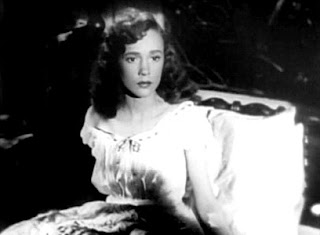The Red House (aka "No Trespassing") (1947)
Starring: Edward G. Robinson, Allene Roberts, Lon McCallister, Rory Calhoun, Judith Anderson, and Julie London
Director: Delmer Daves
Rating: Seven of Ten Stars
The summer teenaged Meg (Roberts) and her friends stand on the verge of adulthood, is the summer they decide to explore the woods on the lands owned by her adopted father (Robinson), over his objections. Soon, secrets that have been buried deep in the forest since Meg was a baby are dragged back into the light, with tragic and deadly consequences.

"The Red House" is a well-paced, expertly acted thriller where country-folk are neither simple nor neighborly.
The cast are all perfect in their roles, with Edward G. Robinson (who transforms from an eccentric, crabby farmer into a menacing, murderous pervert, as his vener is gradually stripped away) and Allene Roberts (who changes from a shy, romantic girl into a young woman willing to risk everything to learn the secrets of her past) give particularly noteworthy performances.
The camera-work and the staging are also very impressive. The way the woods change between day and night are very impressively done, with the menace present when Meg's friend and object of her puppy-love (McCallister) tries to take a shortcut them during a storm, but completely absent during the light of day. The musical score is also extremely well-done and probably somewhat ahead of its time. (My biggest complaint about movies from the 1930s, 1940s, and into the 1950s is that oftentimes the music soundtrack almost seems random in its emotional quality and often not even close to being in sync with what's happening on screen. That can't be said for the music here--it enhances and moves the story along with as much force as the actors and the dialogue they deliver.)
I have nothing but praise for this film, so I think it a sad fact that it is on the verge of becoming "lost." I've seen two different versions of it on DVD--one that so badly hacked up the final scene of the film is missing, and another where the sound is so bad that it was hard to make out what was being said because of static.
If there's a film that deserves to be restored and preserved it's "The Red House." However, since there's no solid commercial hook here, and the film can't be considered "historical", it'll probably never happen.
Despite the poor quality of the sound, "The Red House" is one of the many movies included in the "Dark Crimes 50 Movie Mega-pack" and the even bigger "100 Mysteries" set that made those sets worth the asking price.






.jpg)

















.jpg)






.jpg)
